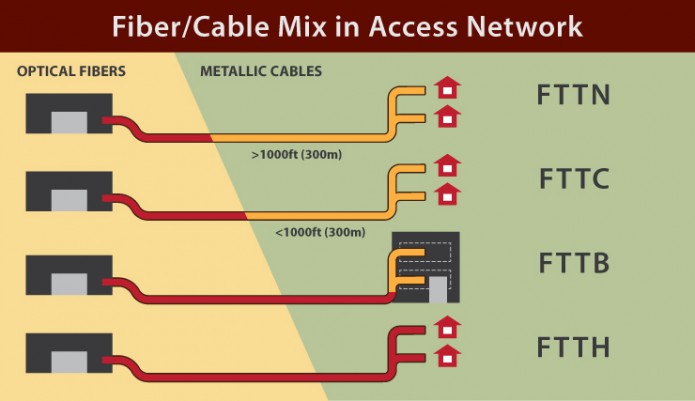Optical fiber broadband is a technology that converts electrical signals carrying data to optical signals and sends the optical signals through transparent glass fibers. The signal conversion process is completed through the optical modems installed on both ends of the optical fiber. Among various transmission media for the broadband network, optical fiber is an ideal one, which features in large transmission capacity, high transmission quality, long repeater spacing and low loss.
Optical fiber access technology provides users with high-speed bandwidth of 10 Mbps, 100 Mbps and 1000 Mbps that can be directly connected with the main crunodes of the internet. With high speed access to local area network (LAN) and high speed interconnection with internet, optical fiber access technology is applied mainly to LANs for business groups and intelligent residences. This article will introduce five common access modes of optical fiber.
Optical fiber + Ethernet Access
Ethernet is a kind of technology for LANs and metropolitan area networks (MANs). When the optical fiber is connected with Ethernet, it is necessary to use switch, photoelectric converter and Cat5e.
Applications: residential areas and commercial buildings where generic cabling and system integration for optical fiber access are completed or easy to be implemented.
Optical Fiber + HomePNA Access
HomePNA is an industry standard for home networking over the existing coaxial cables and telephone wiring within homes. To connected optical fiber with the HomePNA, HomePNA switch (Hub) and HomePNA termination equipment (Modem) are important to connect optical fiber to the HomePNA.
Applications: residential areas and hotel buildings where generic cabling and system integration are undone or inconvenient to be done.
Optical Fiber + VDSL Access
Very-high-bit-rate digital subscriber loop (VDSL) is a technology providing data transmission over a single flat untwisted or twisted pair of copper wires and on coaxial cable. VDSL switch and VDSL termination equipment are essential to connect optical fiber with VDSL.
Applications: residential areas and hotel buildings where generic cabling and system integration are undone or inconvenient to be done.
FTTx + LAN Access
FTTx stands for fiber to the x, where x stands for home, curb, neighborhood, business, etc (as shown in the following figure). LAN refers to local area network. FTTx+LAN access aims at Gigabit Ethernet for the community, fast Ethernet for the building and 10 Mpbs Ethernet for the user.

Applications: it is mainly applied to concentrated residential areas, enterprises and public institutions and universities and colleges. In FTTx+LAN, generic cabling is done in residential areas, high-class offices and student dormitories and teacher dormitories in universities and colleges.
Optical Fiber Access
Optical fiber access with transmission bandwidth from 2 Mbps to 155 Mbps is designed for enterprises and public institutions or groups who need the independent optical fiber-optic high-speed Internet. Since the bandwidth for upload and download is high, optical fiber access is suitable for such activities as remote instruction, tele-medicine and video conference.
Applications: it is applied to concentrated residential areas, communities and offices where generic cabling is done or easy to be implemented. Furthermore, it also applied to enterprises and public institutions or groups who need the independent optical fiber-optic high-speed Internet.
Optical fiber access is expanding due to the demand for broadband in consumer environment. Thus, products such as switches, photoelectric converters and transceivers used in optical fiber access are various in the market. As a professional supplier of optical communication products, Fiberstore supplies many kinds of products used in optical fiber access. Customers may choose the proper optical fiber optic access mode and optical fiber products according to their needs.
Originally published at www.fiber-optical-networking.com/.
No comments:
Post a Comment